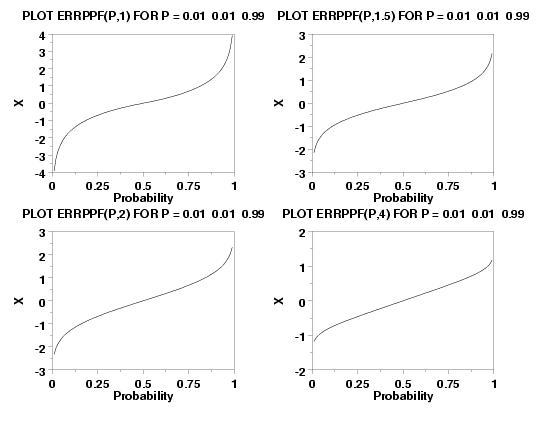

|
ERRPPFName:
Dataplot supports another distribution that is also called the exponential power distribution. This is a different distribution than the one described here (enter HELP PEXPDF for details).
The standard error distribution has the following probability density function:
![f(x,alpha) = EXP(-|x|**alpha)/[2*GAMMA(1+1/alpha)]
-infinity < x < infinity, alpha >= 1](eqns/errpdf.gif)
with
The error percent point function is computed by numerically
inverting the cumulative distribution function
using a bisection method.
For
For The error distribution can be generalized with location and scale parameters in the usual way.
<SUBSET/EXCEPT/FOR qualification> where <p> is a variable, a number, or a parameter in the interval (0,1); <alpha> is a number or parameter specifying the shape parameter; <loc> is a number or parameter that specifies the value of the location parameter; <scale> is a number or parameter that specifies the value of the scale parameter; <y> is a variable or a parameter (depending on what <p> is) where the computed error ppf value is stored; and where the <SUBSET/EXCEPT/FOR qualification> is optional. Note that the location and scale parameters are optional.
LET X2 = ERRPPF(P1,A) PLOT ERRPPF(P,1.5) FOR X = 0.01 0.01 0.99
"Statistical Distributions", Third Edition, Evans, Hastings, and Peacock, Wiley, 2000. "Continuous Univariate Distributions--Volume 2, Second Edition", Johnson, Kotz, and Balakrishnan, Wiley, 1994.
X1LABEL Probability
Y1LABEL X
LABEL CASE ASIS
X1LABEL DISPLACEMENT 12
Y1LABEL DISPLACEMENT 12
MULTIPLOT 2 2
MULTIPLOT CORNER COORDINATES 0 0 100 100
MULTIPLOT SCALE FACTOR 2
TITLE AUTOMATIC
PLOT ERRPPF(P,1) FOR P = 0.01 0.01 0.99
PLOT ERRPPF(P,1.5) FOR P = 0.01 0.01 0.99
PLOT ERRPPF(P,2) FOR P = 0.01 0.01 0.99
PLOT ERRPPF(P,4) FOR P = 0.01 0.01 0.99
END OF MULTIPLOT

Date created: 7/7/2004 |